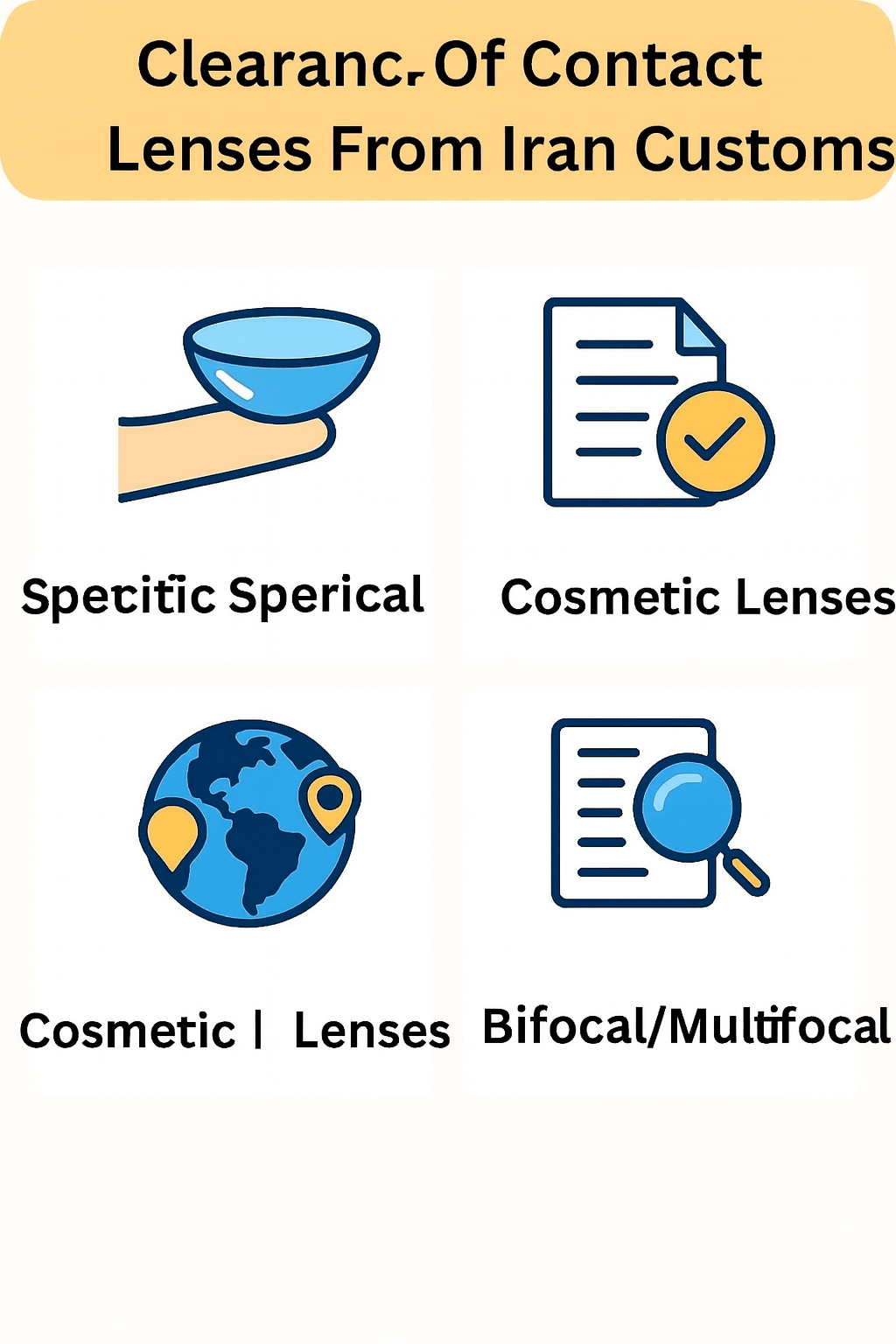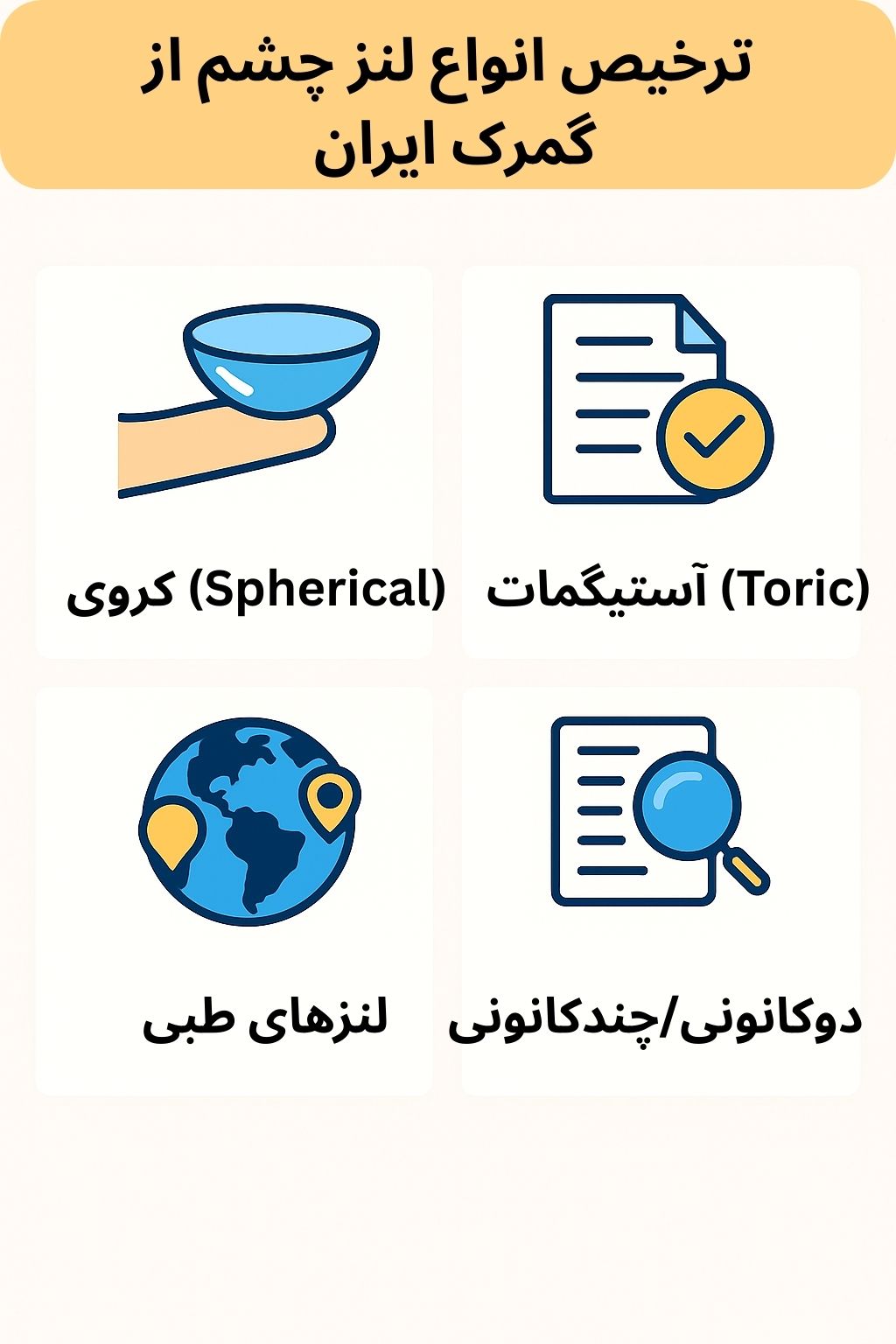Customs Clearance of Eye Lenses in Iran (HS Code + Documents & Permits)
To estimate the time and cost of eye lens customs clearance, contact the experts at Saba Tarkhis.
Instant free consultation
1) Applications and Types of Eye Lenses
Contact Lenses:
Contact lenses are used to correct vision problems such as myopia, hyperopia, astigmatism, and presbyopia.
They are also used to change eye color and are produced in various types such as daily, weekly, monthly, and yearly lenses.
Due to their high variety and ease of use, contact lenses are very popular in the consumer market.
Prescription Lenses:
Prescription lenses, which are usually made of hydrogel or silicone hydrogel, are used to correct more serious vision problems such as severe myopia, hyperopia, high astigmatism, and advanced presbyopia.
Some of these lenses have special features such as filtering blue light or UV, which are used to protect the eyes from light damage.
Prescription lenses may include rigid gas permeable (RGP) lenses and soft lenses, each suitable for their specific applications.
2) Steps for Customs Clearance of Eye Lenses
Obtaining health and medical permits:
The first and most important step in the customs clearance process for eye lenses is obtaining the necessary permits from the Ministry of Health and Medical Education. These permits are issued after a careful review of product quality, production conditions, and its compliance with national and international standards.
Reviewing the quality of raw materials, production processes, and lens packaging are among the items evaluated at this stage.
Without obtaining this permit, it is not possible to clear the goods from customs and entry into the market will be prohibited.
Customs tariff code (HS Code):
Eye lenses are classified under customs tariff code 9001.30.00. This code relates to the classification of optical products and medical equipment.
The customs tariff rate may vary depending on the country of origin and the type of imported lenses. These differences are determined based on trade agreements, type, and technical specifications of the goods.
Using the correct tariff code in the customs declaration is of great importance to prevent legal and financial problems.
Compliance with standards and customs guidelines:
Because eye lenses are in direct contact with the human eye and can potentially affect health, they must follow strict standards in terms of quality, materials used, and production methods.
Iran Customs also examines and evaluates these goods with great sensitivity, and clearance is only allowed if all these standards are met.
Compliance with international standards such as ISO 13485 (medical device quality management) and CE Marking (compliance with EU regulations) is among the items examined at this stage.
Inspection and quality assessment:
At this stage, a sample of imported lenses may be sent to specialized laboratories for quality evaluation. These tests include reviewing raw materials, lens resistance, clarity, and oxygen permeability.
Failure to comply with the required standards and quality may lead to suspension of the clearance process or even return of the goods.
Order registration and customs declaration:
The importer must complete all order registration steps online through the Comprehensive Trade System. At this stage, all required documents, including the commercial invoice, certificate of origin, packing list, and transport documents must be provided.
Accurately completing the customs declaration with precise and correct information is highly important. Any mistake at this stage can lead to delays in clearance or financial penalties.
3) Exporting and Importing Countries of Eye Lenses
4) Special Conditions for Importing Eye Lenses

5) Required Documents for Customs Clearance of Eye Lenses
1. Order registration and import permit:
Order registration in the Comprehensive Trade System: the importer must register the order for their goods via the Comprehensive Trade System. This registration includes precise information about the goods, country of origin, value of the goods, and other related details.
Import permit from the Ministry of Health and Medical Education: for importing eye lenses, which are classified as medical goods, obtaining an import permit from the Ministry of Health is essential. This permit confirms that the imported goods comply with the required health and safety standards.
2. Commercial invoice (Commercial Invoice):
Commercial invoice or proforma invoice: this document includes information such as product specifications, quantity and unit price, total value, payment terms, and the name and address of the buyer and seller. The invoice must be completed accurately and completely so that no problem arises in the clearance stages.
3. Certificate of origin (Certificate of Origin):
Certificate of origin: this document, issued by the Chamber of Commerce of the country of origin, confirms from which country the goods were produced or exported. This document is especially important where preferential tariffs apply.
4. Packing list (Packing List):
Packing list: this document includes details of the packaging of the goods, such as the number of packages, net and gross weight of each package, and their dimensions. This information is very important for customs inspections and clearance.
5. Transport bill of lading (Bill of Lading or Airway Bill):
Sea or air waybill: this document, issued by the transport company, includes shipment details, destination, and the name of the vessel or flight. The bill of lading is considered a document of ownership of the goods and proof of delivery to the carrier.
6. Health and standard certificate (Health and Standard Certificate):
Health certificate: this certificate, issued by the health authorities of the country of origin, confirms that the imported goods have been produced in accordance with health and safety standards.
Certificate of conformity (COC): this certificate confirms that the goods comply with the required national and international standards.
7. Customs declaration (Customs Declaration):
Customs declaration: this document, which must be completed electronically through the customs system, includes complete information about the goods, their value, transport and insurance costs, and other related costs. The declaration must be consistent with other documents so that clearance procedures are carried out correctly.
8. Certificates related to quality and compliance (Certificates of Compliance and Quality):
Quality certificates: in some cases, the importer needs to provide other certificates such as the product quality certificate (for example, CE Marking for Europe), indicating compliance with specific quality and safety standards.
Laboratory certificates: these may be required to confirm the product’s integrity and health and its compliance with necessary standards.
9. Brand registration certificate (Brand Registration Certificate):
If eye lenses are imported under a specific brand, a brand registration certificate may also be required to prevent legal issues during clearance.
10. Other documents (if needed):
Transport insurance documents: insurance policy to cover potential damages during transportation.
Special permits: if importing specific lenses such as colored lenses, special permits from relevant authorities may be required.
Preparing and correctly completing these documents helps you complete the customs clearance process for eye lenses quickly and without problems. In case of non-compliance or incomplete documentation, the goods may be held at customs, or additional costs and penalties may be imposed. Using the services of an experienced customs broker can be very helpful in this regard.
| Item | Short Description | HS Code |
|---|---|---|
| Soft/Silicone Hydrogel Contact Lenses | Vision correction/beauty (UV/Blue Filter depending on model) | 9001.30.00 |
| Rigid Gas Permeable (RGP) Lenses | Specialized prescription lens for astigmatism/keratoconus | 9001.30.00 |
Final tariff classification depends on material, application (medical/cosmetic), sterile packaging, and compliance documents.
Frequently Asked Questions
What is the HS Code for eye lenses?
Typically, contact and RGP lenses are classified under 9001.30.00. Final determination depends on material, use, and compliance documents.
What permits are required for lens clearance?
Permit from the Ministry of Health, CE certificates and/or ISO 13485, health certificate, and, as applicable, laboratory/COC certificates.
What are the main causes of delays in lens clearance?
Incomplete Ministry of Health permits, HS Code discrepancies, missing shipping/invoice/packing list documents, and labeling non-conformities.
Suggested Links
Multimedia Suggestions
- Image filename:
contact-lenses-customs-clearance-iran.jpg - Alt Text: Customs clearance of eye lenses in Iran | HS 9001.30.00
- Caption: «Steps for clearing contact and prescription lenses; from health permit to quality control»
- Infographic: «Document checklist + clearance roadmap + HS Code 9001.30.00 notes»
Special Customs Clearance Services by Saba Brokerage
Our brokerage, using years of experience in clearing medical and hygiene products, offers this comprehensive and specialized set of services for clearing eye lenses. These services include the following:
Pre-import specialized consulting: By providing specialized consulting to importers, this team helps ensure that, before any import action, all required permits are obtained and potential problems at customs are prevented. This consulting includes market condition analysis, selecting the right supplier, and ensuring product compliance with domestic and international standards.
Preparation and completion of required documents: With full knowledge of customs and health regulations, this company prepares and completes all documents and paperwork required for clearing eye lenses, accurately and completely. These documents include sales invoices, quality and compliance certificates, health certificates, and other documents needed to facilitate the clearance process.
Follow-up of customs clearance steps: The professional team continuously and precisely follows all clearance steps, including obtaining health permits and submitting the customs declaration, to carry out the clearance process quickly and accurately. These follow-ups include coordination with customs authorities, conducting required tests, and responding to any possible questions and issues.
Post-clearance services: This team also provides post-clearance services, including consulting on warehousing, distribution, and sale of the imported product. These services help importers manage processes related to supply and sales in the best way after clearance and prevent any problems in the market.
These comprehensive and precise services ensure the facilitation of import and distribution processes for eye lenses for clients.
.png)
